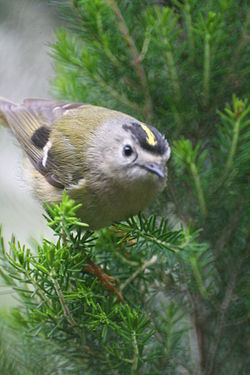| Tenerife goldcrest | |
|---|---|
 | |
| Scientific classification | |
| Kingdom: | Animalia |
| Phylum: | Chordata |
| Class: | Aves |
| Order: | Passeriformes |
| Family: | Regulidae |
| Genus: | Regulus |
| Species: | |
| Subspecies: | R. r. teneriffae |
| Trinomial name | |
| Regulus regulus teneriffae Seebohm, 1883 | |
The Tenerife goldcrest (Regulus regulus teneriffae) is a subspecies of the goldcrest. It closely resembles the continental subspecies, but has a broader black band across the forehead, slightly darker underparts and a longer bill. It breeds in the Canary Islands of Tenerife and La Gomera, where it is a non-migratory resident. It prefers Canary Island Pine forests, but also occurs in laurisilva forests. It is sometimes considered a species in its own right, as Regulus teneriffae.
The populations on La Palma and El Hierro, previously thought to belong to this taxon, are now recognised as, at least, a distinct subspecies, the Western Canary Islands goldcrest R. r. ellenthalerae (Päckert et al., 2006), which evolved from an independent colonisation of the islands.
